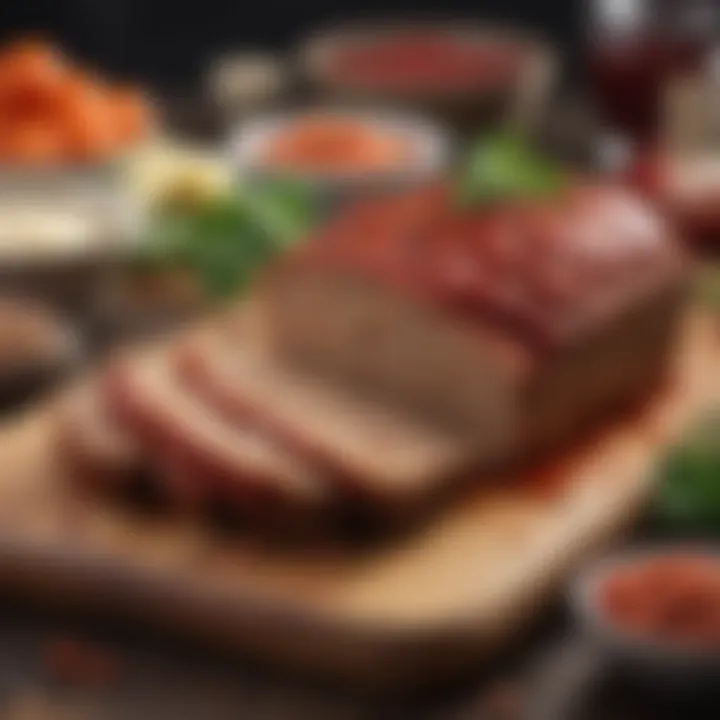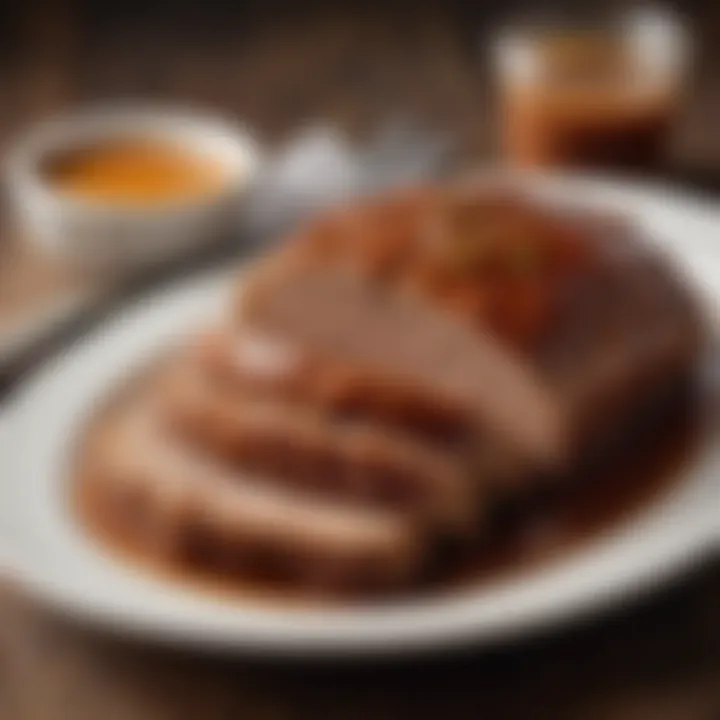Ground Turkey Meatloaf: Healthy and Delicious Recipe


Intro
Ground turkey meatloaf holds a unique place in the world of comfort food. Often associated with family dinners and hearty meals, this dish has evolved through the years, transitioning from a humble staple to a sophisticated blend of flavors and nutrition. It's an intersection where health meets flavor, making it appealing for every age group.
In a time where many are looking to maintain a balanced diet without sacrificing the joy of a good meal, ground turkey meatloaf offers a perfect solution. By utilizing turkey, a leaner protein alternative, home cooks can craft a nutritious dish that doesn't compromise on taste. This dish can accommodate various dietary restrictions, making it versatile and accessible.
The following sections explore this culinary creation from several angles. We'll begin with a recipe overview, including a detailed description of this dish, followed by an in-depth look at the ingredients that make it shine. By diving into the history of meatloaf and how it has adapted to accompany changing culinary trends, we aim to provide a well-rounded perspective that resonates with food lovers of all ages.
Prelude to Ground Turkey Meatloaf
Ground turkey meatloaf is more than just a dish; it represents a blend of tradition and adaptation in the culinary world. As people become more health-conscious, the shift towards leaner meats, particularly turkey, is not just a trend, but a way of life for many. This section aims to introduce the concept of ground turkey meatloaf, focusing on its relevance in modern cuisine while highlighting its comforting nature as a classic favorite.
Defining Meatloaf
Meatloaf, at its core, is a dish made by combining ground meat with various ingredients like breadcrumbs, eggs, and seasonings, shaped into a loaf and baked. The origins of meatloaf can be traced back to the 5th century in ancient Rome, where it was made with a mixture of meats and spices. However, in American cuisine, meatloaf has evolved into a staple comfort food, embodying home cooking.
Ground turkey meatloaf distinguishes itself from its beef counterparts by offering a lighter texture and flavor profile. It’s often seen as a versatile option that can adapt to various seasonings and accompaniments.
The Appeal of Ground Turkey
There are several reasons why ground turkey has gained recognition among home cooks and gastronomes alike. First and foremost, it’s known for being lower in fat compared to traditional beef or pork. This makes it an attractive option for those looking to cut down on saturated fats without sacrificing flavor. Additionally, turkey is a rich source of protein, providing about 24 grams of protein per 3-ounce serving. This fills an essential dietary need, especially for those engaged in fitness and wellness.
When preparing ground turkey, it allows for diverse culinary experiments. Whether it's transforming classic recipes with innovative twists or creating unique flavors inspired by different cuisines, turkey’s capacity to absorb flavors is quite remarkable. People can easily add spices such as cumin for a Southwestern flair or ginger for an Asian touch, giving the meatloaf personality.
In summary, ground turkey meatloaf offers nutritional benefits and culinary flexibility. It stands as a testament to how traditional meals can evolve into healthier versions without losing their essence. Transitioning to this leaner meat can mark the beginning of healthier eating patterns, satisfying comfort food cravings while keeping dietary requirements in mind. The marriage of traditional comfort with modern needs creates a compelling reason to explore ground turkey meatloaf in your own kitchen.
Health Benefits of Ground Turkey
Ground turkey is often hailed as a healthier alternative to its more traditional counterparts like beef or pork. In this section, we’ll break down the specific health benefits that set ground turkey apart, especially in the realm of meatloaf preparation. Knowing these advantages can help home cooks—whether seasoned chefs or newbie kitchen experimenters—make informed choices about their ingredients.
Lower Fat Content Compared to Traditional Meats
One of the primary draws of ground turkey is its lower fat content. When you stack it against ground beef, especially the fattier cuts, ground turkey emerges as a leaner option. For those watching their waistlines or simply trying to eat healthier, this distinction is crucial.
- Lean Cuts: For instance, a serving of ground turkey often contains about 7 grams of fat or less, while ground beef can easily pack in more than double that, depending on the cut.
- Cooking Feedback: The reduced fat means dishes like meatloaf are less greasy, resulting in a more balanced texture and flavor depth.
- Holistic Impact: Choosing turkey over beef may also have wider health implications, including lower cholesterol levels and a decrease in the risk of certain heart diseases. In simple terms, swapping out beef for turkey can be a step in the right direction for those aiming to adjust their eating habits.
Rich Source of Protein
Another highlight of ground turkey is its impressive protein content. Protein is critical for maintaining muscle mass, repairing tissues, and supporting metabolic functions. Healthy adults often require a daily intake of around 46 to 56 grams of protein, and ground turkey can help meet that need effectively.
- Protein Density: A 3-ounce serving of lean ground turkey can offer approximately 22 grams of protein, making it an excellent choice for a post-workout meal or a filling dinner.
- Balanced Meals: Given the versatility of ground turkey, it can easily be paired with various sides—think quinoa, veggies, or whole grain bread—to create a well-rounded plate that satisfies nutritional needs.
- Dietary Considerations: For those on a vegetarian or vegan diet, it's worth noting that turkey provides a key source of complete protein, which can sometimes be tricky to achieve through plant products alone.
Nutritional Profile and Vitamins
Ground turkey doesn't just stop at protein; it also packs a punch with its vitamins and minerals. Its nutritional profile includes B vitamins, selenium, and zinc, which are vital for a myriad of bodily functions.
- B Vitamins: These are essential for energy production and supporting brain health. B6 and B12, often found in high quantities in turkey, are particularly important for cognitive function and red blood cell formation.
- Mineral Content: Selenium, an antioxidant, plays a role in protecting your cells from damage, and zinc is important for immune health.
- Overall Diet Enhancement: Incorporating ground turkey into your diet can thus support both immune functions and energy levels, enhancing overall well-being.
Ground turkey serves as not only a delightful culinary option but also a nutritional powerhouse, making it a sensible choice for family meals and individual dieting goals alike.
In wrapping up this section, it's clear that ground turkey meatloaf isn't just about taste; it's about making smart, nutritious choices that benefit both the palate and the body.
Essential Ingredients for Ground Turkey Meatloaf
When it comes to making a delicious ground turkey meatloaf, the ingredients you choose play a crucial role in the overall flavor and texture. Selecting high-quality ingredients is like choosing the right colors for a painting; it determines the final masterpiece. Here’s a closer look at the key elements that will elevate your meatloaf from mediocre to magnificent.
Choosing the Right Ground Turkey


Not all ground turkey is created equal. When selecting your ground turkey, it's important to consider the lean-to-fat ratio. A common choice is 93% lean and 7% fat, which offers a good balance of flavor and moisture without being overly greasy. If you're aiming for a drier meatloaf, you might opt for 99% lean turkey. However, remember that this leaner option may require additional moisture from other ingredients, lest it turn into a dense brick of sadness. Some might prefer organic or free-range options, not just for ethics but for a more robust flavor.
Binding Agents: Eggs and Breadcrumbs
Binding agents are essential in holding your meatloaf together and preventing it from crumbling apart. Eggs serve as a natural binder, giving structure and moisture to the loaf. They also enhance the richness of the final dish. Breadcrumbs, on the other hand, act like a sponge, soaking up juices and adding necessary texture. You might prefer using panko breadcrumbs for a lighter texture, or regular breadcrumbs for something a bit more traditional. If gluten is a concern, there are alternatives like almond flour or crushed gluten-free crackers that work just as well.
Flavor Enhancers: Herbs and Spices
The real magic happens when you choose the right herbs and spices. Not only do they add flavor, but they also bring a new dimension to your meatloaf, making it memorable rather than just another dish on the table. Classic choices include garlic powder, onion powder, and black pepper. Fresh herbs like parsley or thyme can brighten the flavor profile, while smoked paprika can add a kick of smokiness. Experimentation is key here: a pinch of chili flakes, a dash of Worcestershire sauce, or even some ketchup on top could take it over the edge.
"A good meatloaf is not just about meat; it's about creating a tapestry of flavors that come together in every slice."
Vegetable Additions for Texture
Incorporating vegetables is another smart way to ensure your meatloaf is not only tasty but also nutritious. Finely chopped onions, bell peppers, or even grated carrots can enhance texture and flavor. Not only that, they add moisture, which is particularly helpful in keeping lean ground turkey from drying out. Some might prefer sautéing these vegetables beforehand to enhance their natural sweetness and soften their texture. You could even throw in some zucchini or spinach for extra nutrition without altering the flavor significantly.
To sum up, the essential ingredients for ground turkey meatloaf aren’t just about function; they also bring personality and depth to the dish. By choosing the right turkey, binding agents, flavor enhancers, and vegetable additions, you can create a meatloaf that delights the palate and brings comfort to the dinner table.
Preparing Ground Turkey Meatloaf
Preparing ground turkey meatloaf is an essential step that combines both technique and creativity, ultimately affecting the outcome of this dish. This process influences not just the flavor but also the texture, which can make or break the overall experience of enjoying meatloaf. The goal is to achieve that perfect balance—so that each slice holds together easily while still being moist and flavorful.
Mixing Techniques for Optimal Texture
When you mix ground turkey with other ingredients, the right technique matters greatly. Overmixing can result in a dense meatloaf, while undermixing might leave you with an inconsistent texture. To get it just right, consider following these pointers:
- Gentle Mixing: Use your hands or a sturdy spatula to combine the ingredients without applying too much pressure. Think of it as lightly folding ingredients together rather than kneading dough.
- Wet and Dry Ingredients: Incorporate wet ingredients gradually into the mix. If you're using ingredients like barbecue sauce or Worcestershire sauce, add them to the meat and spices in small amounts, ensuring everything blends uniformly.
- Consider Texture: Adding cooked vegetables, such as finely chopped onions or mushrooms, can infuse moisture and add depth to the meatloaf without making it too heavy. This also helps create a nice contrast in texture.
"The soul of meatloaf lies in its blend; a mindful mix can change the entire dish's character."
Forming the Loaf
Once mixed, the next crucial step is shaping the meatloaf. Properly forming the loaf will influence how it cooks and maintains its integrity during baking. Here’s how to shape it effectively:
- Use Your Hands: Wet your hands slightly to prevent sticking and take the mixture out of the bowl. Form it into an oblong shape rather than a round loaf. This method ensures even cooking throughout.
- Don’t Pack It Too Tight: While it’s important to hold the loaf together, avoid compacting the meat mixture too much. A slightly loose form allows air to circulate better, leading to a more tender result.
- Create a Dimple: Some chefs suggest making a small indentation at the top of the loaf. This creates an area for juices to pool, enhancing flavor and moisture during cooking.
Choosing the Right Pan
Selecting the appropriate pan is more crucial than one might think. The pan you use will affect not only cooking time but also the final texture and juiciness of your meatloaf. Here are factors to keep in mind:
- Loaf Pan vs. Baking Sheet: A traditional loaf pan traps moisture more effectively, leading to a softer loaf. However, if you prefer a crispy exterior, shaping it on a baking sheet may be more suitable.
- Nonstick or Line with Parchment: If you’re using a metal pan, lightly grease it or consider using parchment paper to prevent sticking. You want to easily lift the meatloaf out post-baking without any fuss.
- Monitor the Cooking Surface: If you opt for a metal pan, be aware that cooking may progress faster. Keep an eye on it, especially during the last 10-15 minutes of baking to avoid overcooking.
In summary, preparing ground turkey meatloaf is a union of technique and ingredient selection. Mixing gently, forming correctly, and choosing the right equipment all contribute to creating a meatloaf that is moist, flavorful, and well-structured, fulfilling your culinary aspirations.
Cooking Methods for Meatloaf
When it comes to ground turkey meatloaf, the method of cooking can make all the difference in taste and texture. Each technique brings its unique flair, allowing for a range of flavors and experiences. The choice of cooking method not only impacts how the end product tastes but also how moisture is retained, how easy it is to prepare, and what kind of aromas fill your kitchen. Understanding these factors is essential for crafting the perfect meatloaf.
Baking in the Oven
Baking is perhaps the most traditional way to prepare meatloaf. It's straightforward and allows for even cooking, which is crucial for a dish like meatloaf that needs to reach a safe internal temperature while remaining moist and flavorful.
The keys to successful oven baking include preheating the oven, using a proper baking dish, and monitoring the cooking time. A meatloaf is typically baked at around 350 degrees Fahrenheit. This temperature cooks the meat evenly, helping it stay tender while developing a slight crust on the outside.
- Benefits of Baking:
- Allows for better caramelization of ingredients, enhancing flavors.
- Easier to control cooking time and temperature.
- Can be topped with a glaze or sauce that develops a nice crust.


A well-baked meatloaf leaves your home smelling divine and provides a hearty meal that can be enjoyed in various ways. However, be careful not to overbake it. Trying to achieve a golden crust can backfire, leading to a dry and crumbly result.
Using a Slow Cooker
For those who prefer a more hands-off approach, using a slow cooker can be a game changer. This method offers several advantages, the most notable being convenience. Simply mix your ingredients, form them into a loaf, and let the slow cooker take care of the rest. The low and slow cooking process allows flavors to meld beautifully, and you end up with an incredibly moist meatloaf.
- Considerations for Slow Cooking:
- Make sure to add a bit of liquid to avoid dryness.
- Generally, slow-cooking can take 6-8 hours on low settings, so it requires advance planning.
This method not only keeps the meat moist but also makes it tender, easily falling apart with just a fork. Plus, your kitchen will maintain a warm aroma throughout the day. However, the texture might be denser compared to oven-baked, as there is less airflow.
Grilling as an Alternative
Grilling is often left out of the meatloaf discussion, but it can surprisingly provide a unique flavor profile. When grilled, meatloaf becomes infused with those savory, smoky flavors that come from being cooked over an open flame. This method can be ideal for summer gatherings or when you want to shake things up a bit.
- Grilling Tips:
- Form the meatloaf into smaller patties for easier handling on the grill.
- You can use skewers or form it in a grilling basket to maintain its shape.
While grilling, watch out for flare-ups that can burn the outside while leaving the inside undercooked. It’s important to maintain a consistent heat so it cooks through evenly. When done correctly, grilled meatloaf can deliver a juicy and flavorful experience that's perfect for barbecues and outdoor meals.
"Choosing the right cooking method for your ground turkey meatloaf is as crucial as selecting your ingredients. Each approach brings its characteristics, enriching your culinary experience."
Varieties of Ground Turkey Meatloaf
When it comes to ground turkey meatloaf, the possibilities are vast. The exploration of its varieties not only showcases culinary creativity but also allows individuals to cater to different tastes and dietary needs. Each variety brings its own flair, whether it's through traditional recipes or fusion dishes that blend cultures. By understanding these variations, cooks can find inspiration, making meatloaf a versatile dish in their repertoire.
Classic Meatloaf Recipes
Classic meatloaf often embodies a warm sense of nostalgia, bringing to mind meals shared with family. Traditional recipes typically utilize a straightforward mixture of ground turkey, breadcrumbs, and seasoning, baked to perfection in a loaf pan. Here are some elements that define classic meatloaf:
- Basic Ingredients: Besides ground turkey, key ingredients usually include breadcrumbs, eggs, onions, and common spices like salt and pepper.
- Glaze: Many classic recipes utilize a topping glaze made from ketchup and brown sugar, adding a sweet and tangy finish.
- Cooking Technique: The traditional method is baking in the oven, ensuring even cooking and a pleasing crust.
Despite being simple, classic meatloaf holds a special spot in many kitchens because it’s both filling and comfort-inducing.
International Inspired Variations
Global culinary traditions have inspired many meatloaf recipes, infusing flavors that reflect diverse cultures. For instance:
- Italian Meatloaf: Incorporating herbs like basil and oregano along with mozzarella cheese, this variation takes traditional flavors and enhances them with Italian creativity.
- Mexican Meatloaf: This version often includes spices such as cumin and chili powder, alongside ingredients like black beans and corn. Topped with enchilada sauce or salsa, it’s a zesty twist on the classic.
- Asian Flair: Ingredients like ginger, soy sauce, and scallions easily transform the meatloaf, providing an umami-rich profile. The addition of sesame seeds can add a delightful crunch.
These international adaptations are not only delicious, they help bridge cultures, making meatloaf a canvas to express various gastronomies.
Vegetarian and Vegan Alternatives
For those looking to reduce meat intake or follow vegetarian or vegan diets, ground turkey meatloaf can be creatively reimagined without sacrificing flavor or texture. Here’s how:
- Using Plant-Based Proteins: Substitutes like lentils, chickpeas, or textured vegetable protein serve as hearty bases. They mimic the texture of ground meat beautifully.
- Binding Agents: In place of eggs, alternatives like flaxseed meal or chia seeds can be used to bind the mixture together, offering a similar consistency.
- Flavor Enhancements: The use of smoked paprika, nutritional yeast, and fresh herbs can add depth and variety to the dish.
By exploring vegetarian and vegan alternatives, meatloaf becomes inclusive, allowing everyone to enjoy a slice, regardless of dietary preferences.
The beauty of ground turkey meatloaf lies in its adaptability, allowing cooks to personalize recipes while focusing on health and taste.
Serving Suggestions and Pairings
Serving ground turkey meatloaf can elevate a simple home-cooked meal into a delightful culinary experience. The way you present and complement your meatloaf can significantly enhance the dish's overall appeal and flavor profile. Traditions and personal preferences often drive these choices, so exploring various sides and accompaniments can turn a classic meal into something unique.


It’s a good idea to think about balance when it comes to serving suggestions. The meatloaf itself is hearty, with a savory flavor that generally calls for lighter, more refreshing sides. Understanding how flavors meld can dramatically improve the dining experience, making it memorable for everyone at the table.
Traditional Side Dishes
When it comes to traditional side dishes, one might gravitate toward comfort foods that pair seamlessly with meatloaf. Classic accompaniments often embody nostalgia while complementing the rich taste of the meat. Here are some favorites:
- Mashed Potatoes: Creamy and buttery mashed potatoes create a wonderful contrast to the meatloaf's texture. They absorb gravy beautifully.
- Green Beans: Steamed or sautéed green beans offer a crisp, fresh bite, providing a vibrant color against the meatloaf.
- Cornbread: This slightly sweet bread pairs well with the savory flavors of the meat, delivering a comforting, homey vibe.
- Coleslaw: A tangy slaw can bring a bit of crunch and acidity, cutting through the richness of the meatloaf.
These options not only taste great but also conjure warmth and familiarity, making them the go-to choices for many family meals.
Innovative Accompaniments
Looking to shake things up a bit? Innovative accompaniments can turn the meal into a delightful surprise. Here are some inventive ideas that play with flavors:
- Quinoa Salad: A light and flavorful quinoa salad with cherry tomatoes, cucumber, and a lemon vinaigrette can add a refreshing twist, perfect for a modern touch.
- Roasted Vegetables: Instead of standard steamed vegetables, consider roasting a medley of seasonal ones like bell peppers, zucchini, or carrots. The caramelization from roasting enhances their sweetness and adds depth.
- Sweet Potato Fries: Crispy sweet potato fries can provide an enjoyable contrast in flavor to the meaty loaf while giving it a trendy feel.
- Cauliflower Mash: A lower-carb alternative, cauliflower mash gives a similar creamy texture with a hint of nuttiness that pairs nicely with the turkey.
These modern accompaniments not only engage the palate but also cater to various dietary preferences, such as gluten-free or vegan diets.
The beauty of serving is rooted in creativity. Experimenting with varied sides can not only enhance the flavor but also bring fun to mealtime.
Overall, whether you opt for traditional or innovative pairings, the aim is to create a well-rounded meal that excites the senses. By thoughtfully selecting your sides, you not only complement the ground turkey meatloaf but also build a dining experience that resonates with your guests.
Storing and Reheating Leftovers
When it comes to ground turkey meatloaf, savoring the wholesome taste is not limited to just the day it’s made. Storing and reheating leftovers is just as crucial, and it heavily influences the overall experience. Not only does proper storage extend the lifespan of your delicious creation, but it also preserves flavors and prevents waste. Leftover meatloaf can be a boon on busy weeknights or for quick lunches, letting you enjoy a homemade meal with minimal effort.
Proper Storage Techniques
To keep your ground turkey meatloaf in tip-top shape, consider these storage techniques:
- Cool Down Before Storing: Let your meatloaf reach room temperature before placing it in the fridge. This helps avoid condensation, which leads to unwanted moisture.
- Use Airtight Containers: Choose containers that seal tightly. Not only do they guard against outside odors, but they also keep your meatloaf from drying out.
- Wrap It Up: If you’d rather not use a container, wrapping your meatloaf in plastic wrap or aluminum foil works wonders, too. Make sure it's tightly sealed to prevent air from sneaking in.
- Date and Label: Don’t underestimate this step! Marking leftovers with the date you prepared them gives you a clear timeline for when they should be consumed. A good rule of thumb is to consume them within three to four days.
Reheating Methods to Preserve Flavor
Reheating is an art, and doing it right ensures that your meatloaf tastes just as delightful as when it was freshly baked. Here are some effective methods:
- Oven Reheating: Preheat your oven to 350°F (about 175°C). Place the meatloaf in a baking dish and cover it with foil. This way, it warms through evenly without drying out. Leave it in for about 20-25 minutes or until heated thoroughly.
- Microwave: While a quick fix, be cautious with this method. Slice your meatloaf and place it on a microwave-safe plate. Cover it with a damp paper towel to keep moisture intact. Heat in short bursts, checking in 30-second intervals until warmed.
- Skillet Method: This method is ideal for the crispy edges many love. Heat a skillet on medium-low heat, add a splash of broth or water to create steam, and cover with a lid. This technique warms the meatloaf and adds some moisture, giving it a palatable texture.
Quick Tip: Always ensure that the internal temperature of reheated meatloaf reaches at least 165°F (75°C) for safety.
By implementing proper storing and reheating practices, you keep your flavor intact, and more importantly, it allows your culinary creations to continue feeding your family well beyond the initial dinner. Leftovers, when treated with care, can become meals just as cherished as the first round.
Culmination and Final Thoughts
In exploring the world of ground turkey meatloaf, it becomes clear that this dish is more than just a quick family meal; it embodies a delightful intersection of health, tradition, and culinary creativity. This article has illuminated various aspects of meatloaf, from understanding its historical significance to discovering the nuances of ingredient selection and preparation methods. By focusing on ground turkey, we've highlighted a healthier alternative without sacrificing flavor or texture, tapping into modern dietary needs and preferences.
Recap of Preparation and Benefits
To summarize, preparing ground turkey meatloaf involves a few key steps:
- Selecting Quality Ingredients: Choosing the right ground turkey ensures a flavorful base. Mixing in fresh herbs, quality eggs, and ideally-baked breadcrumbs raises the profile tremendously.
- Mixing and Binding: Ideal texture is paramount in meatloaf. The combination of moist turkey, eggs, and breadcrumbs creates a loaf that holds together while being tender to the bite.
- Cooking Techniques: Whether baking, using a slow cooker, or grilling, each method offers unique advantages. Baked meatloaf presents a lovely crust on the exterior, while slow cooking contributes to a juicy texture—a win-win for any household.
In terms of benefits, incorporating ground turkey meatloaf into one’s diet comes with several health rewards:
- Lower Fat Content: Compared to red meats, ground turkey presents a leaner option that aligns well with heart-health-conscious goals.
- Protein Source: Being rich in protein, it supports muscle health and overall strength, particularly important for families with active lifestyles.
- Vitamins and Nutrients: From B vitamins to selenium, turkey is a nutritional powerhouse that supports various bodily functions.
Encouragement to Experiment and Create
The beauty of ground turkey meatloaf lies in its versatility. It invites creativity in the kitchen, allowing cooks to explore various flavor combinations and cultural influences. From Italian herbs of basil and oregano to the bold spices found in Moroccan cuisine, the options are full of possibilities.
- Try Different Ingredients: Consider folding in ingredients like spinach, mushrooms, or a medley of peppers for added nutrition and personality.
- Explore Global Flavors: Take inspiration from around the world. For instance, incorporating teriyaki sauce or sriracha can introduce an exciting twist to traditional recipes.
- Vary the Cooking Method: Don’t hesitate to switch it up. Using a grill can add a nice char to your meatloaf, while a slow cooker can turn this dish into a comforting, set-it-and-forget-it meal.
"Cooking is like love; it should be entered into with abandon or not at all."
Ultimately, meatloaf is not just a dish but also a canvas for culinary expression—an invitation to experiment, personalize, and make something truly unique to your taste. So, roll up your sleeves, gather your family or friends, and embark on your own ground turkey meatloaf adventure. Your kitchen is waiting, and the delightful aroma of a freshly baked loaf will add warmth to your table in no time.







